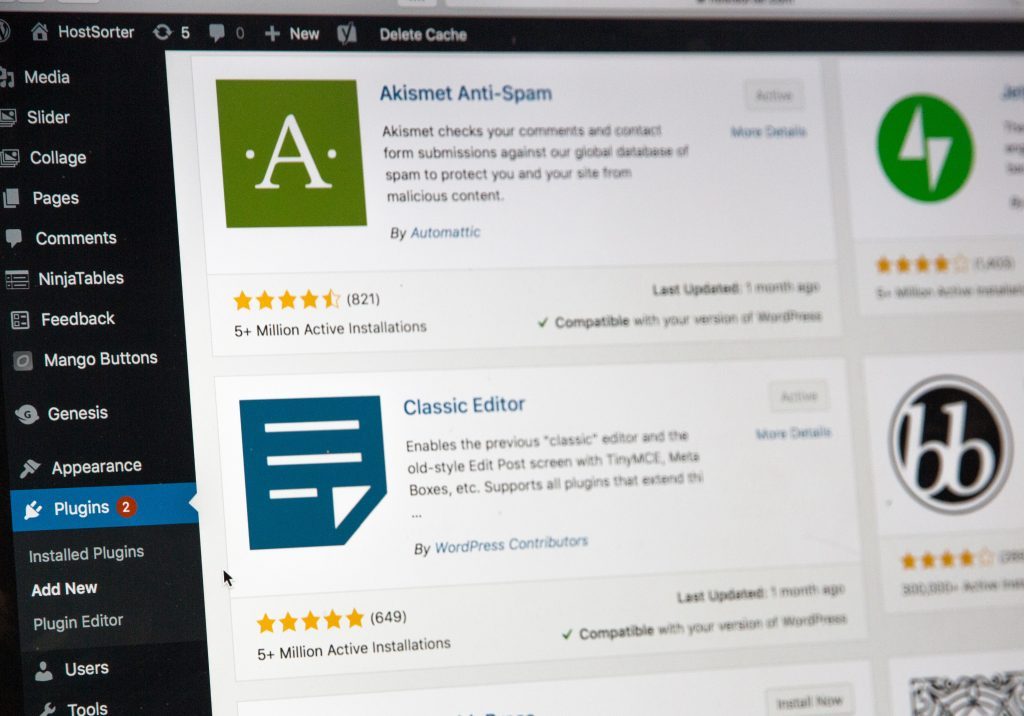Show Up In Google Search With These WordPress SEO Strategies…
At Convert Digital, we’re massive fans of WordPress websites (providing WordPress Web Design In Sheffield) and to be honest, so is the rest of the world; with an estimated 810 million websites, or 43% of the entire internet being powered by WordPress. Although having a WordPress site is clearly a great choice, it’s not all you need to drive business online, it’s imperative to optimise your site too, if you want to see any real results.
Using SEO on your site; optimising it to show in Google search results (or ‘SERPs’ as they’re known), is crucial to driving sales and enquiries. In our latest blog, we’re showing you how to develop a foolproof SEO strategy for your WordPress website, from initial planning to conviction, based on our years of experience. If you’re looking for more conversions online, whether that’s for eCommerce, a Business Website or even your own blog; read on and get your WordPress SEO strategy up and running.
Keyword Research: The Foundation of SEO
Before jumping into your new SEO strategy, you’ll need to undertake thorough keyword research. Keyword research is all about finding out a) what search terms your website already ranks for and b) search terms you’d like to rank for. In simple terms, you’ll be able to find out what your customers are searching to find websites like yours (and your competitors).
With this in mind, it’s easier to develop an SEO strategy to target search.
Tools like Google’s Keyword Planner, Ahrefs, and SEMrush can assist you in discovering high-traffic keywords with manageable competition. Search Engine Journal suggest that 50% of users are more likely to click on a result if it exact keywords they’ve searched for, with over 25% clicking the top result; emphasising the importance of choosing the right ones and ranking for them.
Here’s what they can do at a glance:
Google Keyword Planner
With Google holding a 90% of the search engine market it’s worth while taking note of any free tools they offer.
Google’s Keyword Planner works through Google Ads, helping advertisers identify relevant keywords for their paid search campaigns. While primarily designed for advertisers, it’s an invaluable resource for any website owner. To access the Keyword Planner, you’ll need to sign up for a Google Ads account, but you don’t necessarily need to run an active ad campaign to use it.
Using the Keyword Planner, you can input seed keywords related to your business or niche, and it will generate a list of related keywords along with metrics such as search volume, competition level, and suggested bid prices for advertising. This data helps you identify high-traffic keywords that align with your content strategy.
Before you go straight for those massive volume keywords, think. Depending upon your level of SEO skill, available time and budget, it pays to be realistic and pragmatic. Instead of focusing all your efforts on the biggest volume keywords, consider those smaller volume searches that are a little easier to capitalise on, with less competition. Using Google’s suggested bid pricing and competition level can help you identify those keywords in the ‘sweet spot’; searches that will generate traffic, but aren’t impossible to rank for.
Ahrefs
Ahrefs is a comprehensive SEO toolset that offers a vast array of features, with keyword research being one of its primary strengths. Ahrefs’ Keywords Explorer provides detailed insights into keyword metrics and competitive analysis.
With Ahrefs, you can perform keyword research using plenty of filters, such as search volume, keyword difficulty, and click-through rate (CTR). It also offers a “Keyword Difficulty” feature, which estimates how difficult it would be to rank for a specific keyword based on the authority of the top-ranking pages in SERP’s. Additionally, “Parent Topic” and “Also Rank For” features help you discover related keywords and other content ideas to create a more well rounded content strategy.
SEMRush
Our personal favourite; SEMRush is another powerful all-in-one SEO platform that offers an extensive range of tools, including advanced keyword research capabilities. The Keyword Magic Tool within SEMRush provides an in-depth analysis of keywords related to your seed term.
SEMRush not only presents keyword ideas but also provides essential data like search volume, keyword difficulty, and the competitive density of the search results. You can also explore long-tail keyword opportunities and discover potential competitors for each keyword. The tool’s interface is user-friendly, making it easy to access actionable insights that can inform your content strategy.
As with all keyword research, when using SEMRush, particularly on a new, or low ranking website, it’s important to find a balance between search volume and difficulty, giving you enough opportunity to drive decent traffic that’s achievable.
Once you’ve compiled a list of target keywords, it’s time to figure out the content and web pages you’ll create to target these keywordS. Usually, this comes in two main formats; blogging (where you would write about the particular keyword you’re trying to rank for) and optimising static service pages (or, creating new, keyword specific Landing Pages). If you’d like to get a better idea of how content marketing works, be sure to check out our Content Page.
Let’s take a look at them both…
Blogging: Content Is (Still) King
You’ve probably heard it before, but it bears repeating: content is (still) king! High-quality, valuable, and engaging content can attract new users, keep them on your website longer and encourage them to share your links with others; all of which adds up to a boost in organic rankings.
Aside from a purely SEO benefit, content can help increase affinity with your customers too. According to a Clutch survey, 82% of consumers say they have a more positive opinion of a company after reading custom content.
Generating Blog Ideas
Generating blog titles around your chosen keywords will require a combination of creativity, research, and understanding of user intent. Here’s a step by step guide to help you come up with ideas:
Understand User Intent
Different users may have different intentions when searching for different keywords. Some might be looking for basic definitions and explanations, whilst others might need more in depth information, doing more research or even committing to buy your products or services. Categorise user intent into informational, commercial, and transactional, and tailor your blog titles accordingly.
At Convert Digital, we also like to categorise content and user intent by ‘journey’ stage. To do this, you can use the tried and tested AIDA model, which highlights the steps any customer will take from initial product or service discovery to conversion. Here’s how that might look for your business from a blog perspective:

Pro tip: Don’t be tempted to produce Transactional content only! It might seem tempting to target only those that are ready to buy, but in the long run, you’ll generate more business at a higher value if you connect with customers at every step of their purchasing journey.
Brainstorm Title Ideas
It may sound simple but, a good brainstorming session is a great place to start for each step of your customers journey. Link your keywords using clouds; considering different angles, formats, and levels of expertise. Here’s some examples we came up with for the term ‘SEO’:
- The Ultimate Guide to SEO: Strategies for Success
- Local SEO: Boosting Your Business’s Visibility in Sheffield
- SEO Trends 2023: What You Need to Know
- 10 Powerful SEO Techniques to Skyrocket Your Rankings
- Beginner’s Guide to On-Page SEO: Tips and Tricks
- Comparing Top SEO Tools: A Comprehensive Review
- Mastering Technical SEO: Tips from Experts
- E-Commerce SEO: Strategies for Online Stores
- SEO vs. PPC: Choosing the Right Strategy for Your Business
Answer Common Questions
Although Google seems to be moving away from FAQ’s, there’s still some worth in addressing your customer’s queries. Not only can it (still) help your website rank for common terms, but it should also improve conversion rates, answering your customers questions right on your landing pages, so they don’t have to go elsewhere.
To generate a list of questions to answer, you can use Answer The Public (which offers two free searches per day) or, simply make a note of what your customers ask on a day to day basis.
The aforementioned tools such as SEM Rush can also help with this.
Copy Your Competitors
If you can’t beat them, join them! Looking at your competitors content is a good place to start if your looking to generate ideas. The key is to be as good, if not better than them.
A good strategy for this is to search your target keywords using Google and take a look at the top three results. Firstly, assess the page you land on (which can influence the On-Page optimisation of your WordPress website, more on that shortly) but also the accompanying blogs they write; paying close attention to those that link through to service pages.
Don’t just copy your competitors content, deliver something better. You’ll have a much better chance of outranking competitors if you offer new insights, more up to date, relevant information or a unique perspective that hasn’t been done before. Here’s a few things you could add to provide better content:
- Add statistics: Adding facts and figures to your blog will strengthen your content.
- Add images: Images that effectively explain your content could make all the difference, they could even show in image search too.
- Add videos: Something most companies overlook, video is a nice, rich piece of content to add to your blog and improve page experience.
- Add authority: Have industry leading experience? Use it! By adding quotes and personal experience you’ll rank well in Google.
On-Page Optimisation: Making Your Content SEO-Friendly
On-page optimisation, which is all about tailoring your static, ‘regular’ pages (usually service pages) to keywords, plays a vital role in improving your search engine rankings. There are a few key elements you can improve using WordPress, to improve your on page SEO:
- Meta Tags & Descriptions: Using primary keywords in your meta tags is always good practice, which will directly impact the organic rankings of your WordPress site. Furthermore, although meta descriptions don’t directly improve the position of your site in SERP’s, including relevant keywords in your meta descriptions can significantly impact click-through rates meaning more traffic from new organic users.
- Headings also contribute to SEO success. Remember to use a clear, hierarchical structure for headings on your pages and blogs. You should be using only one H1 tag (signifying your page title), along with a logical layout of H2 and H3 subheadings as a minimum.
- Image optimisation is another crucial aspect of on-page SEO. Compressing images to reduce page loading times is essential, and adding descriptive alt text along with keyword-rich image file names helps search engines better understand your visuals.
A word of caution: Don’t be tempted to stuff keywords into image alt text if it doesn’t work! Instead, clearly, and concisely describe what your image is about. - A study by Backlinko found that shorter URLs tend to rank higher in search results, highlighting the importance of concise and descriptive URLs.
Page Speed: Faster is Better
Google considers page speed as a ranking factor, and research by Google itself shows that as page load time goes from one second to ten seconds, the probability of a mobile site visitor bouncing increases by 123%, making it a must for any WordPress SEO strategy. This is why a streamlined, speedy web design is crucial for faster speeds and better rankings. (Incidentally, if you need help with yours, we offer SEO friendly Web Design In Sheffield, check it out!)
To improve page speed, consider using caching plugins, optimising images, and choosing a reliable hosting provider. Whilst some can be tricky to really master, most caching plugins have a ‘walkthrough’ which should still give you some improvement.
Mobile Responsiveness: A Must-Have Feature
With the majority of internet users accessing websites on their mobile devices, mobile responsiveness is no longer optional; it’s a must. According to a study by Statista, 50.81% of all web page views in the UK came from mobile devices in 2021. Therefore, ensuring that your WordPress theme is mobile-friendly and provides a seamless user experience on various devices is essential for attracting and retaining UK mobile users.
Utilise SEO Plugins: Your WordPress Allies
WordPress offers a plethora of SEO plugins to simplify your optimisation efforts. Among these, Yoast SEO and All in One SEO Pack are two of the most popular and feature-rich options.
Yoast SEO is the most popular SEO plugin in the UK, with a usage share of 62.2%, according to a survey by W3Techs. With over five million active installations, Yoast SEO is a powerful and user-friendly plugin that guides you through the optimisation process. It provides real-time feedback on your content, helping you optimise your posts for your chosen keywords, readability, and overall SEO score. The plugin also assists with meta title and description creation, ensuring they meet the ideal length and keyword placement for maximum impact in search results. Yoast SEO’s XML sitemap feature helps search engines crawl and index your site more efficiently, improving your chances of ranking higher.
All in One SEO Pack is another top choice, boasting an extensive array of features to optimise your WordPress site. The plugin helps you generate XML sitemaps, manage canonical URLs to avoid duplicate content issues, and integrate with social media platforms for better social sharing. All in One SEO Pack also supports Google Analytics integration, giving you valuable insights into your site’s performance and traffic.
The Wrap Up
Remember that SEO is an ongoing process, and staying updated with the latest trends and algorithm changes is crucial for maintaining and improving your rankings over time. Invest time and effort into optimising your WordPress site wand you’ll reap the rewards with increased organic traffic, higher rankings, and greater online success.
Don’t forget to share this with your network if you’ve enjoyed reading!









